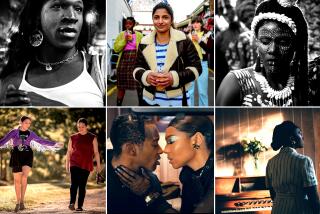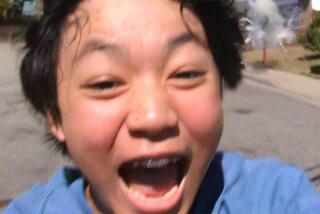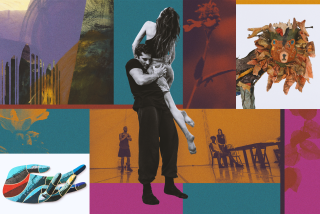A film fest propelled by movement
Itâs fitting that the classic 1948 British ballet feature âThe Red Shoesâ is the highest-profile inclusion in this yearâs Dance Camera West Festival, for the filmâs combustible mix of dancing, love and madness turns up repeatedly in the monthlong festivalâs 36 other offerings.
Now in its third year, Dance Camera West is directed by Lynette Kessler and Kelly Hargraves, former dancers who set out to expose local audiences to a hybrid art that isnât widely available here. âThereâs a festival in New York thatâs been going for 30 years,â Kessler said this month, âand one in London, Paris, Amsterdam, Athens, Monte Carlo, Barcelona, Toronto, Seattle and San Francisco.â
Kessler and Hargraves thought it crazy that there wasnât one in the capital of the film industry, and they started by selecting films from other festivals. Now, however, they call for submissions, and this year there were more than 200 entries. Said Hargraves: âWe sort of have this traveling cinema idea -- bringing the dance to the people in different ways.â The pair chose to spotlight âThe Red Shoesâ this year because it contains what Kessler called âthe quintessential choreography made to be seen on-screen.â
Set for June 16 at the John Anson Ford Amphitheatre, âThe Red Shoesâ also reflects this festivalâs focus on the backstage pressures of the dance world -- though several of its most distinctive films ignore theatrical dance entirely in favor of something more primal.
Shot on five continents by Michelle Mahrer and Nicole Ma, the spectacular âDances of Ecstasyâ (June 11 at the El Rey Theatre) juxtaposes cultures and religions to try to show how dance renews and deepens the sense of community and oneness with nature that Western societies have lost. Forget dance as entertainment. Dance here is a form of healing, a means to transcend egocentric isolation, a pathway to God.
Thereâs even a medical explanation for the way that dance induces mystical states of being: Vibrations from the dancerâs movement travel up the spine to the base of the brain, producing ecstasy or trance. And you can see that theory put into practice in one âEcstasyâ sequence after another -- none more engulfing than the phenomenal Moroccan womenâs dances of spiritual possession.
Many of this filmâs thematic preoccupations recur in âAnna Halprin: Returning Home,â Andy Abrahams Wilsonâs profile of a great postmodern innovator (June 13 at the UCLA Hammer Museum). Here, though, we do need some perspective on Halprinâs extraordinary impact and influence on the concert dance world. Without it, we are left with nothing but a gorgeously shot valentine to a lovable eccentric who likes to paint herself blue and sit naked in a forest, smearing herself with mud.
The festivalâs backstage/offstage focus becomes most evident, and sometimes problematic, in the other documentaries screening at the Hammer Museum. Many of the filmmakers had access to some of the rarest footage imaginable, but they remain stingy with these treasures, as if there was an unwritten law: No dance sequence will last longer than the minimum time it takes to illustrate a spoken insight.
In other words, dance itself isnât allowed to speak through its own means, whether weâre watching Annette von Wangenheimâs exhaustively researched study of the origins of German dance theater, âKurt Jooss: A Commitment to Danceâ (June 13), or Tonia Shiminâs engaging biography of a pioneering American dancer, choreographer and teacher, âMary Anthony: A Life in Modern Danceâ (June 20).
Thereâs plenty of classroom footage and interview tributes in these films. But if Joossâ 1932 epic âThe Green Tableâ and Anthonyâs 1956 dance drama âThrenodyâ are as important as weâre told, we should see more than tantalizing fragments -- or the slick little linked dissolves used to obliterate major choreography in Evann Siebensâ âJose Limon: Moving Into the Futureâ (June 20), an otherwise thoughtful look at how a company survives its founderâs death.
Devotedly and sometimes glumly educational, these documentaries give Dance Camera West intellectual weight, but itâs the short experimental collaborations between choreographers and film or video directors that supply the kinetic muscle and sense of immediacy.
REDCAT launches the festival Friday with two nights of these flights of fancy -- and youâd better get there on time for the first program or youâll miss Reynir Lyngdal and Katrin Hallâs wildly accomplished comic short, âBurst,â from Iceland. Here a manâs stifled sexual needs lead to bravura domestic warfare and then -- when a bulging faucet suddenly bursts (ah, symbolism!) -- a kind of postmodern aquacade ensues. You want dancing, love and madness, plus a flood that might daunt even Noah? Seek no further.
Beyond its other achievements, the film is a testament to Icelandic craftsmanship, for where else in the world would a bedroom be utterly watertight?
Many of the other REDCAT films place dancers in unusual or picturesque settings, often compromising dance values in pursuit of novel manipulations of time and imagery. Indeed, the big cliche of the 2004 festival is footage that has been shot or processed so the dancing looks blurred, even at its correct (natural or original) speed. Itâs as if these directors donât want us to get involved in movement itself, only the larger context or overview of a scene.
Indeed, American director-choreographer Andrew Wassâ pithy âCollateral Damageâ (Saturday) uses no dancers at all but adopts stop-motion animation techniques to create a whimsical pas de deux for two war toys. It ends abruptly with a title slide thatâs anything but whimsical: âHow many have died because of an unelected lying president?â
At the other extreme, British director-choreographer Chris Ho looks with a sculptorâs eye at human anatomy in âSecond Handâ (also Saturday), isolating limbs in close-up and making the simplest actions momentous.
Working with six choreographers, Catherine Maximoff manages to deliver satisfactions to both dance fans and the film crowd in her atmospheric French short âUzes Quintetâ (Friday), a cavalcade of dancing highlighted by some awesome contortion solos and duets by the members of Collectif Peeping Tom.
Besides its scheduled screenings, Dance Camera West will offer audiences an opportunity to view all the other submissions at EZTV in Santa Monica -- plus a closing-night outdoor film âhappeningâ in Coldwater Canyon Park that will use objects in nature as projection screens. The real novelty, however, may be the inclusion of a work adapted from the stage, a familiar dance-for-camera genre that the festival usually ignores.
On the Saturday REDCAT program, Edouard Lockâs âAmeliaâ is the same âAmeliaâ that Lockâs Canadian company, La La La Human Steps, performed at UCLA in November -- but utterly different in design and mood.
The 80-minute stage âAmeliaâ embraced darkness and mystery, with dancers and musicians constantly moving in and out of view behind webbed scenic panels. The 60-minute film âAmeliaâ explores facets of brightness, with the dancers materializing inside a giant wooden humidor that seems to have no exits (except maybe at the top), no place to hide.
Directed by Lock, âAmeliaâ is nothing but dance, brilliantly shot, relentlessly in your face, astonishingly fast. On film, though, Lockâs choreography is humanized by what the darkness and distance camouflaged on the stage: which woman is getting wrinkles around her eyes, which man is going bald.
Even La La La firebrands age and flicker out. The lesson of âAmeliaâ -- and maybe of the festival itself -- is to dance this hard, this fast, this gloriously while you still can.
*
A roaming festival
Dance Camera West runs from June 4 to 26 in six venues.
June 4 and 5: REDCAT, Walt Disney Concert Hall, 631 W. 2nd St., Los Angeles. 8 p.m. $10. (213) 237-2800.
June 11: El Rey Theatre, 5515 Wilshire Blvd., L.A. $17 (advance); $22 (at the door). 8:30 p.m. Includes dance party. (323) 936-6400.
June 13 and 20: UCLA Hammer Museum, 10899 Wilshire Blvd., Westwood. 2 p.m. Free. (310) 443-7000.
June 16: John Anson Ford Amphitheatre, 2580 Cahuenga Blvd. East, Hollywood. $10 (suggested donation). 8 p.m. (323) 461-3673.
June 23 to 26: EZTV Viewing Library, 1629 18th St., No. 6, 18th Street Arts Center, Santa Monica. Noon to 4 p.m. Free. (310) 829-3389.
June 26: TreePeople âOutside the Edgesâ outdoor screening, Coldwater Canyon Park, 12601 Mulholland Drive, Los Angeles. 8 p.m. $10. (213) 480-8633.
For further information: www.dancecamerawest.org
More to Read
Only good movies
Get the Indie Focus newsletter, Mark Olsen's weekly guide to the world of cinema.
You may occasionally receive promotional content from the Los Angeles Times.










